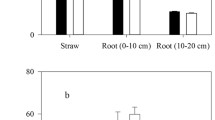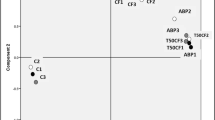Abstract
Incorporation of genetically modified crops in the cropping system raises the need for studying the effect of these crops on the soil ecosystem. The current study aimed to compare the effect of Bacillus thuringiensis (Bt)- and non-Bt-cotton (Gossypium hirsutum L.) genotypes on rhizosphere properties under fertilized and unfertilized soil conditions. One non-Bt-cotton (IUB 75) and four Bt-cotton varieties (IUB-222, MM-58, IUB-13, FH-142) were sown in a Randomized Complete Block Design (RCBD) in a factorial fashion with three replications under unfertilized (T1) and fertilized (T2 at NPK 310–170–110 kg ha−1) soil conditions. The culturable soil bacterial population was recorded at flowering, boll opening, and harvesting stages, while other rhizosphere biological and chemical properties were recorded at harvesting. Results revealed that Bt-cotton genotypes IUB-222 and FH-142 showed significantly higher rhizosphere total nitrogen, NH4 +–N, available phosphorus, and available potassium. Total organic carbon and microbial biomass carbon was also maximum in the rhizosphere of IUB-222 under fertilized conditions. Similarly, bacterial population (CFU g−1) at flowering stage and at harvesting was significantly higher in the rhizosphere of IUB-222 as compared to non-Bt- (IUB-75) and other Bt-cotton genotypes under same growth conditions. It showed that Bt genotypes can help in maintaining soil macronutrients (total nitrogen, available phosphorus, and available potassium) under proper nutrient management. Moreover, Bt-cotton genotypes seem to strengthen certain biological properties of the soil, thus increasing the growth and yield capability, maintaining available nutrients in the soil as compared to non-Bt cotton, while no harmful effects of Bt cotton on soil properties was detected.




Similar content being viewed by others
References
Abid, M., Ashfaq, M., Khalid, I., & Ishaq, U. (2011). An economic evaluation of impact of soil quality on Bt (Bacillus thuringiensis) cotton productivity. Soil and Environment, 30(1), 78–81.
Alexander, M. (1982). Most probable number method for microbial population. In A. L. Page (Ed.), 0-ccc method of soil analysis. Part 2. Agronomy no. 9 (pp. 815–820). Madison: American Society of Agronomy.
Anayeva, N. D., Suysan, E. A., Chernova, O. V., & Wirth, S. (2008). Microbial respiration activities of soils from different climatic regions of European Russia. European Journal of Soil Biology, 44(2), 147–157.
Arshad, M., Anjum, S., Gogi, M. D., Yaseen, M., Asghar, M., Tayyib, M., Haider, K., Faisal, H., & Naeem, U. (2009). Farmers perceptions of insect pests and pest management practices in Bt cotton in the Punjab, Pakistan. International Journal of Pest Management, 55(1), 1–10.
Berendsen, R. L., Pieterse, C. M. J., & Bakker, P. A. H. M. (2012). The rhizosphere microbiome and plant health. Trends Plant Sci, 17, 478–486.
Berg, G., & Smalla, K. (2009). Plant species and soil type cooperatively shape the structure and function of microbial communities in the rhizosphere. FEMS Microbiology Ecology, 68, 1–13.
Bremner, E., & Kessel, V. (1990). Extractability of microbial 14C and 15N following addition of variable rates of labeled glucose and ammonium sulphate to soil. Soil Biology and Biochemistry, 22, 707–713.
Carvalhais, L. C., Dennis, P. G., Fedoseyenko, D., Hajirezaei, M. R., Borriss, R., & Wiren, N. V. (2011). Root exudation of sugars, amino acids and organic acids by maize as affected by nitrogen, phosphorus, potassium and iron deficiency. Journal of Plant Nutrition and Soil Science, 174, 3–11.
Dennis, P. G., Miller, A. J., & Hirsch, P. R. (2010). Are root exudates more important than other sources of rhizodeposits in structuring rhizosphere bacterial communities? FEMS Microbiology Ecology, 72, 313–327.
Duncan, D. B. (1955). Multiple range and multiple F-test. Biometrics, 11, 1–42.
Dunsfield, K. E., & Germida, J. J. (2004). Impact of genetically modified crops on soil and plant associated microbial communities. Journal of Environmental Quality, 33, 806–815.
Gee, G. W., & Bauder, J. W. (1986). Particle size analysis. In A. Klute (Ed.), Methods of soil analysis. Part 2 nd (Ed.) Agron. Monogr. 9 (pp. 383–411). Madison: ASA and SSSA.
Glick, S. H., Cassman, K. G., & Grattan, S. R. (1989). Exploitation of soil potassium in layered profiles by root systems of cotton and barley. Soil Science Society of America Journal, 53, 146–153.
Gomez, K. A., & Gomez, A. A. (1984). Statistical procedures for agricultural research (2nd ed.). New York: John Wiley & Sons Inc..
Griffiths, B. S., Caul, S., Thompson, J., Birch, A. N. E., Scrimgeour, C., Cortet, J., Foggo, A., & Hackett, C. A. (2006). Soil microbial and faunal community responses to Bt maize and insecticide in two soils. Journal of Environmental Quality, 35, 734–741.
Gul, S., Khan, N. U., Batool, S., Baloch, M. J., Munir, M., Sajid, M., Khakwani, A. A., Ghaloo, S. A., Soomro, Z. A., & Kazmi, S. F. (2014). Genotype by environment interaction and association of morphoyield variables in upland cotton. Journal of Animal Plant Sciences, 24(1), 262–271.
Hawesm, M. C., Gunawardena, U., Miyasaka, S., & Zhao, X. (2000). The role of root border cells in plant defense. Trends in Plant Science, 5, 128–133.
Houlden, A., Timms-Wilson, T. M., Day, M. J., & Bailey, M. J. (2008). Influence of plant developmental stage on microbial community structure and activity in the impact assessment of transgenic plants on soil ecosystem. Applied Ecology and Environmental Research, 6(3), 1–19.
Jackson, M. L. (1962). Soil chemical analysis. Engl wood Cliff: Prentice Hall, Inc..
Jenkinson, D. S., & Ladd, J. N. (1981). Microbial biomass in soil, measurement and turn over. New York: Marcel Dekker.
Kamphake, L. J., Hannah, S. A., & Cohen, J. M. (1967). Automated analysis for nitrate by hydrazine reduction. Water Research, 1(3), 205–216.
Kapur, M., Bhatia, R., Pandey, G., Pandey, J., Paul, D., & Jain, R. K. (2010). A case study for assessment of microbial community dynamics in genetically modified Bt cotton crop fields. Current Microbiology, 61, 118–124.
Kennedy, A. C. (1998). The rhizosphere and spermophere. Upper Saddle River: Prentice Hall.
Khan, N. U., & Hassan, G. (2011). Genetic effects on morphological and yield traits in cotton (G. hirsutum L.) Spanish Journal of Agricultural Research, 9(2), 460–472.
Khan, N. U., Hassan, G., Marwat, K. B., Farhatullah, Kumbhar, M. B., Parveen, A., Aiman, U., Khan, M. Z., & Soomro, Z. A. (2009a). Diallel analysis of some quantitative traits in G. hirsutum L. Pakistan Journal of Botany, 41(6), 3009–3022.
Khan, N. U., Hassan, G., Marwat, K. B., Farhatullah, Batool, S., Makhdoom, K., Khan, I., Khan, I. A., & Ahmad, W. (2009b). Genetic variability and heritability in upland cotton. Pakistan Journal of Botany, 41(4), 1695–1705.
Koyama, A., Wallenstein, M. D., Simpson, R. T., & Moore, J. C. (2014). Soil bacterial community composition altered by increased nutrient availability in Arctic tundra soils. Frontiers in Microbiology, 5(10), 516–3389.
Lynch, J. M., & Panting, L. M. (1980). Cultivation and the soil biomass. Soil Biology and Biochemistry, 12, 29–33.
Masto, R. E., Chhonkar, P. K., Singh, D., & Patra, A. K. (2006). Changes in soil biological and biochemical characteristics in a long-term field trial on a sub-tropical inceptisol. Soil Biology and Biochemistry, 38, 1577–1582.
Mina, U. (2011). Effect of cotton on enzyme activity and microorganisms in rhizosphere. Journal of Agricultural Sciences, 3(1), 1916–9760.
Mina, U., & Choudhary, A. (2012). Impact of transgenic cotton varieties on activity of enzymes in their rhizosphere. Indian Journal of Biochemistry and Biophysics, 49, 195–201.
Moodie, C. D., Smith, H. W., & McCreery, R. A. (1959). Laboratory manual for soil fertility (pp. 1–75). Washington: Department of Agronomy, State College of Washington Pullman.
Nardi, S., Concheri, G., Pizzeghello, D., Sturaro, A., Rella, R., & Parvoli, G. (2000). Soil organic matter mobilization by root exudates. Chemosphere, 5, 653–658.
Paterson, E., Gebbing, T., Abel, C., Sim, A., & Telfer, G. (2007). Rhizodeposition shapes rhizosphere microbial community structure in organic soil. New Phytologist Trust, 173, 600–610.
Pindi, P. K., & Sultana, T. (2013). Bacterial and fungal diversity in rhizosphere soils of Bt and non-Bt cotton in natural system. Bulgarian Journal of Agricultural Sciences, 19(6), 1306–1310.
Ryan, P. R., & Delhaize, E. (2001). Function and mechanism of organic anion exudation from plant roots. Annual Review in Plant Physiology and Plant Molecular Biology, 52, 527–560.
Ryan, J., Estefan, G., & Rashid, A. (2001). Soil and plant analysis laboratory manual (2nd ed.). Aleppo: International Center for Agriculture in Dry Areas (ICARDA) 172p.
Sarkar, B., & Patra, A. K. (2009). Microbial biomass pools in the rhizosphere soils of transgenic Bt and non-Bt cotton on a sub-tropical haplustept. New Delhi: Indian Agricultural Research Institute (IARI).
Sarkar, B., Patra, A. K., Purakayastha, T. J., & Megharaj, M. (2009). Assessment of biological and biochemical dindicators in soil under transgenic Bt and non-Bt cotton crop in a sub-tropical environment. Environmental Monitoring and Assessment, 156, 595–604.
Shen, R. F., Cai, H., & Gong, W. H. (2006). Transgenic Bt cotton has no apparent effect on enzymatic activities or functional diversity of microbial communities in rhizosphere soil. Plant & Soil, 285, 149–159.
Shukla, M. K., Lal, R., & Ebinger, M. (2004). Principal component analysis for predicting corn biomass and grain yields. Soil Science, 169, 215–224.
Sims, J. R., & Jackson, G. D. (1971). Rapid analysis of soil nitrate with chromotropic acid. Soil Science Society of America Journal, 35(4), 603–606.
Sinha, N. K., Mohanty, M., Meena, B. P., Das, H., Chopra, U. K., & Singh, A. K. (2013). Soil quality and indicators under continuous cropping system in the ecosystem of India. African Journal of Agriculture Research, 9(2), 285–293.
Steel, R. G. D., Torrie, J. H., & Dicky, D. A. (1997). Principles and procedures of statistics—a biometrical approach (3rd ed.). Singapore: McGraw Hill Book International Co.
Stotz, H. U., Pittendrigh, B. R., Kroymann, J., Weniger, K., Fritsche, J., Bauke, A., & Mitchell-Olds, T. (2000). Induced plant defense responses against chewing insects. Ethylene signaling reduces resistance of Arabidopsis against Egyptian cotton worm but not diamondback moth. Plant Physiology, 124, 1007–1018.
Tarafdar, J. C., Rathore, I., & Vandana, S. (2012). Effect of Bt-transgenic cotton on soil biological health. Applied Biological Research, 14(1), 15–23.
Tesfaye, M., Temple, S. J., Allan, D. L., Vance, C. P., & Samac, D. A. (2001). Over-expression of malate dehydrogenase in transgenic alfalfa enhances organic acid synthesis and confers tolerance to aluminum. Plant Physiology, 127, 1836–1844.
Toljander, J. F., Santos-Gonzalez, J. C., Tehler, A., & Finlay, R. D. (2008). Community analysis of arbuscular mycorrhizal fungi and bacteria in the maize mycorrhizosphere in a long-term fertilization trial. FEMS Microbiology Ecology, 65, 323–338.
Tyagi, S. (2007). Association of fluorescent pseudomonas with rhizosphere of wheat. Plant Archives, 7, 919–920.
U.S. EPA (2001). Biopesticides registration action document for the Bacillus thuringiensis (Bt) plant-incorporated protectants. US EPA, Washington, DC. Available at: http://www.epa.gov/oppbppd1/biopesticides/pips/bt_brad.htm, accessed on: 25–08-2016.
Velmourougane, K. (2013). Indian Council of Agricultural Research, Central Institute for Cotton Research, Nagpur, Maharashtra, India. pp.108–114.
Watanabe, F. S., & Olsen, S. R. (1965). Test of an ascorbic acid method for determining phosphorus in water and NaHCO3 extracts. Soil Science Society of America Proceedings, 29, 677–678.
Yan, W. D., Sh, W. M., Li, B. H., & Zhang, M. (2007). Overexpression of a foreign Bt gene in cotton affects the low-molecular-weight components in root exudates. Pedosphere, 17, 324–330.
Acknowledgements
We acknowledge the efforts of Dr. Alejandro J. Pieters and Mikenna Smith for editing the manuscript. We are thankful to the Department of Soil Science, University College of Agriculture and Environmental Sciences, The Islamia University of Bahawalpur, Pakistan, for providing the research facilities. The authors are also grateful to the Department of Plant Breeding and Genetics, University College of Agriculture and Environmental Sciences, The Islamia University of Bahawalpur, Pakistan, for the provision of cotton genotypes.
Author information
Authors and Affiliations
Corresponding author
Rights and permissions
About this article
Cite this article
Ahamd, M., Abbasi, W.M., Jamil, M. et al. Comparison of rhizosphere properties as affected by different Bt- and non-Bt-cotton (Gossypium hirsutum L.) genotypes and fertilization. Environ Monit Assess 189, 278 (2017). https://doi.org/10.1007/s10661-017-5994-3
Received:
Accepted:
Published:
DOI: https://doi.org/10.1007/s10661-017-5994-3




